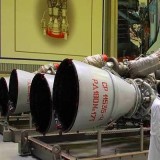Exclusive: U.S. Marine Corps VMFA-312 Conducts Daily F/A-18C Fighter Jet Operations in Panama

{loadposition bannertop}
{loadposition sidebarpub}
According to information published by the U.S. Department of Defense on April 8, 2025, U.S. Marine Corps F/A-18C Hornet aircraft with Marine Fighter Attack Squadron (VMFA) 312 took off from Panama Pacifico Airfield, Panama, marking the continuation of the squadron’s day-to-day operations in support of an expanded strategic security partnership with the Republic of Panama.Follow Army Recognition on Google News at this link
A U.S. Marine Corps F/A-18C Hornet from Marine Fighter Attack Squadron 312 (VMFA-312) takes off from Panama Pacifico Airfield, Panama, during routine flight operations on April 8, 2025. (Picture source: U.S. DoD)
The presence of VMFA-312, known as the “Checkerboards,” in Panama represents a major step forward in the United States’ renewed defense posture in Central America. Operating from the former Howard Air Force Base—now Panama Pacifico Airfield—this deployment reflects Washington’s commitment to regional security amid emerging geopolitical threats and increased global competition for influence in Latin America.
VMFA-312 is an elite U.S. Marine Corps aviation unit assigned to Marine Aircraft Group 31, 2nd Marine Aircraft Wing. With a distinguished combat history dating back to World War II, the squadron today flies the F/A-18C Hornet, a multirole fighter platform designed for air superiority, precision ground attacks, close air support, and maritime strike missions. The “Checkerboards” are instantly recognizable by their iconic tail markings and are regularly deployed to serve as a forward-deployed air combat force.
Their current mission in Panama is part of a broader strategic initiative that includes heightened interoperability between U.S. and Panamanian forces. The timing of this deployment aligns with the 2025 Central America Security Conference (CENTSEC), hosted in Panama City from April 8 to 10, where regional defense leaders reaffirmed their joint commitment to countering shared security challenges such as narco-trafficking, organized crime, and foreign influence operations.
VMFA-312’s combat-ready F/A-18C Hornet aircraft are armed with advanced weaponry suited for the mission in Panama. The jets are capable of deploying AIM-120 AMRAAM and AIM-9 Sidewinder missiles for air-to-air engagements, as well as AGM-65 Maverick missiles, JDAMs (Joint Direct Attack Munitions), and laser-guided bombs for ground precision strikes. These capabilities ensure that the squadron can fulfill a wide range of operational roles, from deterrence and air patrols to direct support of partner forces on the ground.
This deployment comes in the wake of an important bilateral agreement between the U.S. and Panamanian governments. On April 10, 2025, both parties signed a Memorandum of Understanding (MOU) enabling U.S. access to key facilities—including Rodman Naval Station, Howard Air Force Base, and Cristóbal Colón Naval Air Base—for joint exercises and operations. The agreement strictly forbids the establishment of permanent American military bases, reinforcing Panama’s sovereignty while facilitating robust, temporary cooperation.
A centerpiece of the agreement is the establishment of a “first and free” transit arrangement, which ensures toll-free and priority access for U.S. and Panamanian warships through the Panama Canal. This strategic concession enhances the mobility and readiness of U.S. forces in the hemisphere, while symbolizing a reinvigorated security alliance.
The deployment of VMFA-312 also serves a deterrent purpose amid growing concerns over China’s expanding presence in the region. U.S. defense officials have expressed unease about Chinese-operated infrastructure near the Panama Canal, which they view as potential security risks. In response, Panama has initiated measures to reduce its dependence on China’s Belt and Road Initiative and committed to auditing Chinese-controlled port facilities.
By reinforcing its military presence with a capable aviation combat unit like VMFA-312, the United States aims to secure vital maritime routes, assist in regional counter-narcotics efforts, and ensure stability in one of the world’s most strategically important crossroads. This mission reflects a deepening of defense cooperation and underscores Washington’s enduring role as a key security partner in the Western Hemisphere.

{loadposition bannertop}
{loadposition sidebarpub}
According to information published by the U.S. Department of Defense on April 8, 2025, U.S. Marine Corps F/A-18C Hornet aircraft with Marine Fighter Attack Squadron (VMFA) 312 took off from Panama Pacifico Airfield, Panama, marking the continuation of the squadron’s day-to-day operations in support of an expanded strategic security partnership with the Republic of Panama.
Follow Army Recognition on Google News at this link
A U.S. Marine Corps F/A-18C Hornet from Marine Fighter Attack Squadron 312 (VMFA-312) takes off from Panama Pacifico Airfield, Panama, during routine flight operations on April 8, 2025. (Picture source: U.S. DoD)
The presence of VMFA-312, known as the “Checkerboards,” in Panama represents a major step forward in the United States’ renewed defense posture in Central America. Operating from the former Howard Air Force Base—now Panama Pacifico Airfield—this deployment reflects Washington’s commitment to regional security amid emerging geopolitical threats and increased global competition for influence in Latin America.
VMFA-312 is an elite U.S. Marine Corps aviation unit assigned to Marine Aircraft Group 31, 2nd Marine Aircraft Wing. With a distinguished combat history dating back to World War II, the squadron today flies the F/A-18C Hornet, a multirole fighter platform designed for air superiority, precision ground attacks, close air support, and maritime strike missions. The “Checkerboards” are instantly recognizable by their iconic tail markings and are regularly deployed to serve as a forward-deployed air combat force.
Their current mission in Panama is part of a broader strategic initiative that includes heightened interoperability between U.S. and Panamanian forces. The timing of this deployment aligns with the 2025 Central America Security Conference (CENTSEC), hosted in Panama City from April 8 to 10, where regional defense leaders reaffirmed their joint commitment to countering shared security challenges such as narco-trafficking, organized crime, and foreign influence operations.
VMFA-312’s combat-ready F/A-18C Hornet aircraft are armed with advanced weaponry suited for the mission in Panama. The jets are capable of deploying AIM-120 AMRAAM and AIM-9 Sidewinder missiles for air-to-air engagements, as well as AGM-65 Maverick missiles, JDAMs (Joint Direct Attack Munitions), and laser-guided bombs for ground precision strikes. These capabilities ensure that the squadron can fulfill a wide range of operational roles, from deterrence and air patrols to direct support of partner forces on the ground.
This deployment comes in the wake of an important bilateral agreement between the U.S. and Panamanian governments. On April 10, 2025, both parties signed a Memorandum of Understanding (MOU) enabling U.S. access to key facilities—including Rodman Naval Station, Howard Air Force Base, and Cristóbal Colón Naval Air Base—for joint exercises and operations. The agreement strictly forbids the establishment of permanent American military bases, reinforcing Panama’s sovereignty while facilitating robust, temporary cooperation.
A centerpiece of the agreement is the establishment of a “first and free” transit arrangement, which ensures toll-free and priority access for U.S. and Panamanian warships through the Panama Canal. This strategic concession enhances the mobility and readiness of U.S. forces in the hemisphere, while symbolizing a reinvigorated security alliance.
The deployment of VMFA-312 also serves a deterrent purpose amid growing concerns over China’s expanding presence in the region. U.S. defense officials have expressed unease about Chinese-operated infrastructure near the Panama Canal, which they view as potential security risks. In response, Panama has initiated measures to reduce its dependence on China’s Belt and Road Initiative and committed to auditing Chinese-controlled port facilities.
By reinforcing its military presence with a capable aviation combat unit like VMFA-312, the United States aims to secure vital maritime routes, assist in regional counter-narcotics efforts, and ensure stability in one of the world’s most strategically important crossroads. This mission reflects a deepening of defense cooperation and underscores Washington’s enduring role as a key security partner in the Western Hemisphere.




